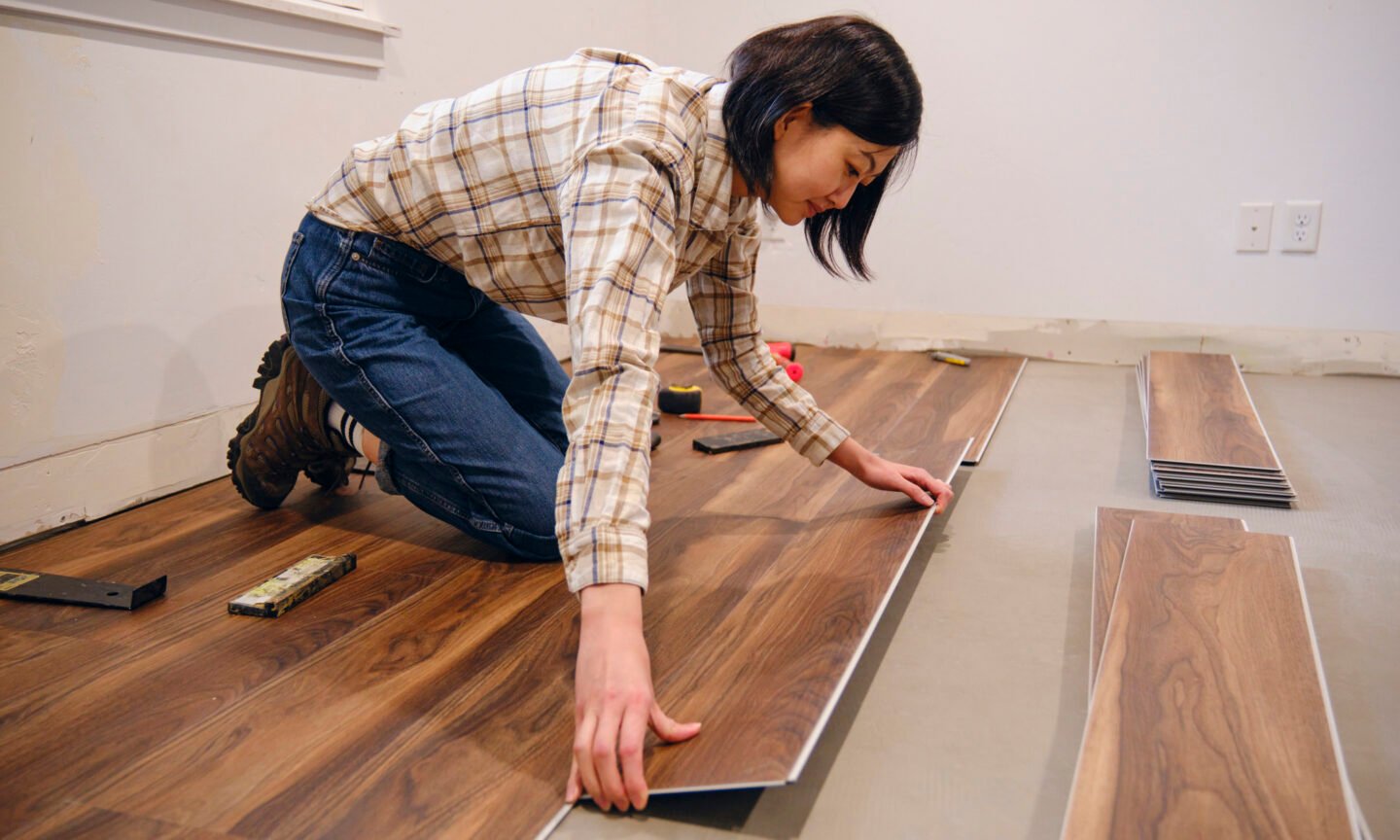[ad_1]
The average cost of laminate flooring is about $3,000 with labor, or about $3 to $13 per square foot. Materials typically cost $1 to $5 per square foot. Installing laminate flooring on 1,000 square feet may cost $3,000 to $13,000, depending on the materials and other factors.
What is laminate flooring?
Laminate is a type of flooring that can mimic the look of hardwood or other natural materials. Typically, it’s made from fiberboard materials (chipped wood) and melamine resin, compressed into four purposeful layers:
-
Back layer. This acts as a protective moisture barrier and helps keep the floor balanced.
-
Core layer. Made of high-density fiberboard, this layer helps prevent dents and damage from moisture.
-
Design/image layer. This layer of the floor contains a high-resolution, photorealistic image that gives the floor its distinctive appearance.
-
Wear layer. This transparent top layer protects the floor from spills, stains, water, furniture, animals, high-heeled shoes and fading.
Laminate flooring manufacturers are subject to revised and relatively new rules that regulate the use of formaldehyde in their production.
Types of laminate flooring
Laminate flooring can be made to look like natural wood, stone or tile and is manufactured in a variety of plank widths and thicknesses. These floors are available in a scale of durability ratings, known as abrasion class (AC) ratings, each best suited to specific situations. Usually, the higher the AC rating of laminate flooring, the higher its price tag.
-
AC1 (Moderate residential). These floors are for light foot traffic, such as closets or bedrooms.
-
AC2 (General residential). These floors are for living rooms, dining rooms and other places with moderate foot traffic.
-
AC3 (Residential/moderate commercial). These floors can handle high-traffic residential use as well as light commercial use, such as hotel rooms and offices that don’t get off-street traffic.
-
AC4 (General commercial). AC4-rated floors generally are for commercial spaces with a lot of foot traffic, such as restaurants, stores and offices.
-
AC5 (Heavy commercial). This rating describes floors designed to hold up in busy, high-traffic commercial locations like government buildings and large retail spaces
World Floor Covering Association. Laminate. Accessed Nov 19, 2024..
Factors that affect the cost to install laminate flooring
Many factors in addition to AC rating affect the cost of to install laminate flooring. These include:
-
Thickness. Generally, thicker floors are more costly than thinner ones.
-
Finish. Glossy finishes may be more expensive than matte or semi-matte finishes because extra manufacturing processes are required to achieve a high-gloss shine.
-
Installation type. Click-lock style flooring is typically less expensive than glued laminate style flooring.
-
Texture. Smooth and embossed textures are often the most affordable; brushed, oiled and hand-scraped textures are often more expensive.
-
Appearance. The type of wood the laminate floor mimics can affect its price.
-
Extra features. Scratch-resistance, water-resistance, noise-resistance, underlayment, low-maintenance flooring, and approval for cork underlayment or underfloor warming may add to the cost of your materials. Laminate flooring that already has underlayment fitted in it is typically the costliest option.
-
Underlayment and pad. Different thicknesses and types of underlayment have different price tags.
Additionally, your costs will increase if you need more professional labor required to install your floor. Types of labor that can increase your costs include:
-
Moving and replacing furniture.
-
Demolition, removal and disposal of your old floor covering, unless the laminate floor can be installed over your existing floor surface.
-
Preparing the subfloor for laminate flooring installation.
-
Labor charges per square foot.
-
Any extra materials required to install your particular floor, including transitions and trim pieces.
Installing laminate flooring
Labor costs can account for 20% to 50% of the total price for professionally installed laminate flooring. If you’re considering doing your own installation, be aware that as DIY home renovations go, installing laminate flooring is considered to be one of the simpler projects for amateurs, but with a few important considerations.
-
Floor type. Only click-lock design laminate floors — which don’t require glue, staples, tape or nails, and instead are floated over an existing subfloor — are typically a good fit for DIY projects. Glued laminate floor designs generally require a professional installer.
-
Required supplies. Unless you already own all the tools and other materials required to install a click-clock laminate floor, purchasing these tools will reduce the amount of money you save by doing the project yourself.
-
Job complexity. If your space is complex (requiring cuts around heating registers, doorways or stairs, for example), consider hiring a professional installer.
-
Time commitment. Installing a click-lock laminate floor in an average-sized room takes at least a few days, and possibly as much as four or five days for the labor itself, depending on the complexity of your project and your skill level. This installation time is in addition to allowing two or three days for the flooring to rest in the area prior to installation, so the flooring can acclimate to the room’s environment, preventing expansion issues.
Can I get financing for a home repair or improvement?
Your contractor may offer some financing options (either through a partner or a payment plan), but there are other — any maybe better — financing options available.
Home equity loan or HELOC
Which financing option is best for me?
The best financing option for you will depend on how much money you need, when you need the money, what project you’re doing and how long you need to pay the money back. If it’s something that’ll add value to your home, a HELOC or home equity loan may be your best option because the value of your house could increase by more than the amount of the loan.
On the flip side, if it’s a less expensive repair, a credit card is probably your best option if you want to pay no interest or earn rewards. Personal loans can apply to both small and large repairs or renovations, and they may make sense if you don’t have much equity in your home.
Some home improvement contractors offer their own financing options. Before taking this option, shop around and see how their offer compares with other loans.
Regardless of what you choose, make sure you compare interest rates, terms and fees with any financing options you’re considering. This will ensure you get the best deal.
 Quicken Loans: NMLS#3030 |
||
|---|---|---|
National / regionalNational |
National / regionalNational |
National / regionalNational |
[ad_2]
Source link

